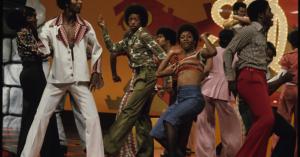Pre-season’s greetings my fellow information seekers! No no, I’ve missed you more. We’re shining this week’s E-Hollywood spotlight on the “hypnic jerk”. While it may sound like a funky, dance from the 70’s, it describes a far more psychedelic physiological phenomenon. Can you dig it? I knew you could.
When I first heard about the “hypnic jerk” I was…
17 years old or so, nodding off in statistics class to that dream where I’m giving my Nobel Prize speech and no one in the audience is laughing at my jokes because I’m not wearing any pants. Anyway, in the dream the floor of the stage suddenly collapsed and I fell into this bottomless pit of my subconscious. At that very moment I was in fact sliding out of my desk. My arms and legs flailed wildly, like a cat trying not to take a bath, knocking my textbooks onto the floor and waking me from my pants-less slumber. What I didn’t know then was that this phenomenon is actually experienced by many people (the falling feeling, not the no pants thing).
Hypnic Jerk
In the movie “Inception” (kick-ass movie btw) they refer to it as “the kick,” that moment while asleep when the sudden sensation of falling jolts you awake. Most of us have experienced this at some point and the feeling is anything but pleasant. What I experienced that day in high school was actually a rare scenario of dream incorporation.
The funny thing about R.E.M. is…
You may not know this but during the surprisingly brief stage of R.E.M sleep, where all of our dreaming takes place, your body is temporarily paralyzed. It’s quite normal, and when you think about it, evolutionarily advantageous not to be able to act out your dreams. Otherwise, we would be jumping out the window every time we’re chased by zombie hordes in our sleep. In fact the only motor function that doesn’t seem to be impaired during this stage of sleep is our eye movement. This is how the R.E.M. stage or rapid eye movement gets its name.
Of course, the line separating the dream state from the waking state is notoriously blurry and it is proposed that the hypnic jerk phenomenon occurs during that awkward intermediate stage where the region of our (brain beneath the cortex) most active when we are awake intrudes on our sleepy-time region of the brain (ventrolateral preoptic nucleus, or VLPO) that manipulates our sleep. I will affectionately refer to this region of the brain as “Vilpo” that’s right,…Vilpo Baggins.
Stay with me this gets interesting…
The VLPO region of the brain is practically next door neighbors with the optic nerve (anterior of the hypothalamus). Why so close? The theory is that during the day Vilpo is busy collecting information from our eyes about light levels (time of day) and it uses this solar sense of time to direct our sleep cycle. Yeah..sounds good, but more importantly it is neurotransmitters like serotonin and adenosine that activate the VLPO. These crafty neurotransmitters accumulate throughout the day until they reach a concentration that causes us to turn in for the night. While we sleep the VLPO releases it’s own neurotransmitters that inhibit the neurons that are most active and frisky when we’re awake so that we can stop being so frisky and get some rest. So neurotransmitters encourage sleep and neurotransmitters keep us asleep.
Sleep is not passive. To sleep and to wake means that there is always some element that must actively be kept under control.
While we are awake the VLPO is inhibited by opposing neurotransmitters. When we are awake our reticular activating system, R.A.S is awake. This region of the brain is BFF’s with the cortex, hypothalamus, and cerebellum which control basically every conscious and semi-conscious thing we do (walking, eating, SEX, etc.). So one cluster of neurons inhibits another cluster of neurons in a daily battle of sleep and wakefulness where both sides win and both sides lose.
So here’s the deal…
Hypnic jerks seem to occur as a kind of involuntary hiccup of motor control during the crossing over phase into sleep paralysis. The mechanism behind this is still poorly understood but it is the last gasp of waking motor function. It is a paradoxical, involuntary muscle reflex (Myoclonus) and it is pretty common in healthy people. We do know that these episodes can be triggered by persistent stress and anxiety, which is never good. It is also indicated that strenuous activity throughout the day can trigger an episode. It may sound paradoxical but you can actually be “too tired” to get a good night’s sleep and you can cheat your body out of its natural progression into the stages of sleep by being either too exhausted or too wired before you cut out the lights.
Let’s say you let 6 hours of YouTube videos play on your laptop while you typed up a research paper, opened 20 website browsers, and then shut your computer without shutting anything down. It may sound like a lousy way to treat your computer but we do it to our brains all the time…we don’t “go to bed” we just slam our laptops shut without “shutting down” first.
Hypnic Jerks seem to serve as a haunting reminder of the gaps in our understanding of the mechanism of sleep.
Human beings make straight lines and sharp angles. Our buildings have perfect triangles, solid walls, and mathematically proportional rectangles and squares. We believe in boundary lines and cut off points but the human brain itself, with its mosaic of soft tissue and blood vessels, is not confined by the same boundaries. You have to consider that perhaps no one portion of the brain is designated strictly to sleeping or waking but that these two states of consciousness are far more intimately connected, perhaps even dependent on each other. The phenomenon of sleep could be nothing less than an infinitely complex culmination of subtle details and relationships within the vast landscape of the brain.
Stay curious, stay classy, and never stop learning my friends 🙂




